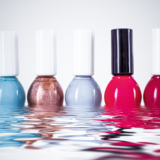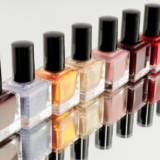Maintaining Acrylic Nails for Swimmers

Introduction
Acrylic nails are a popular choice for those seeking durable and stylish manicures. These artificial nails offer the strength and longevity needed for a polished look, even under challenging conditions. However, for swimmers, maintaining acrylic nails can present unique challenges. The frequent exposure to water, particularly chlorinated pool water, can weaken these nails, leading to potential damage. This article explores how swimmers can effectively maintain their acrylic nails, covering essential pre-swim preparations, in-water protection strategies, post-swim care routines, and long-term maintenance practices.
1. Understanding Acrylic Nails
I. Composition of Acrylic Nails
Acrylic nails are created by mixing a liquid monomer with a powder polymer, forming a pliable substance that can be applied to the natural nail. Once exposed to air, this mixture hardens into a solid, durable layer. This process allows for shaping, filing, and styling the nails in various ways, offering both strength and aesthetic appeal.
II. Durability and Strength
Acrylic nails are known for their durability, making them a popular choice for those looking for long-lasting manicures. However, their strength can be compromised by frequent exposure to water, particularly the chemicals found in swimming pools. Over time, water can seep between the acrylic layer and the natural nail, leading to potential lifting, weakening, and discoloration.
III. Common Issues Faced by Swimmers
Swimmers often encounter several challenges when maintaining acrylic nails. The constant exposure to chlorinated water can cause the nails to become brittle and discolored. Additionally, the prolonged submersion in water can weaken the bond between the acrylic and the natural nail, increasing the risk of lifting or breakage. Understanding these issues is the first step in developing an effective nail care routine.
2. Pre-Swim Nail Preparation
I. Importance of Nail Health
Healthy natural nails are essential for the longevity and strength of acrylic nails. Before applying acrylics, it’s crucial to ensure that the natural nails are in good condition. This includes regular moisturizing, keeping the cuticles healthy, and ensuring the nails are free from any fungal infections or damage.
II. Pre-Swim Care Routine
Before heading to the pool, swimmers should take certain precautions to protect their acrylic nails. This includes applying a fresh topcoat to seal the nails and prevent water from seeping underneath the acrylic. Additionally, inspecting the nails for any cracks or chips before swimming can help prevent further damage.
III. Choosing the Right Nail Products
The quality of the acrylic products used can significantly impact the durability of the nails. For swimmers, it’s essential to choose products designed to withstand exposure to water and chemicals. Nail products that include added strengtheners or protective barriers are particularly beneficial for those who spend a lot of time in the pool.
3. Protecting Acrylic Nails While Swimming
I. Best Practices for In-Water Nail Protection
To protect acrylic nails while swimming, it’s important to minimize their exposure to water as much as possible. Swimmers should avoid staying in the water for extended periods and be mindful of how they use their hands to prevent accidental bumps or pressure on the nails.
II. Use of Protective Gloves
One of the most effective ways to protect acrylic nails while swimming is by wearing protective gloves. These gloves act as a barrier between the nails and the water, reducing the risk of damage. When selecting gloves, it’s important to choose ones specifically designed for swimming, as they offer the best protection.
III. Avoiding Harsh Chemicals
Chlorine and other chemicals found in pool water can weaken acrylic nails. After swimming, it’s important to rinse the hands and nails thoroughly with fresh water to remove any residual chemicals. This simple step can help prevent the nails from becoming brittle and discolored.
4. Post-Swim Care Routine
I. Immediate Post-Swim Actions
Immediately after swimming, it’s crucial to dry the hands and nails completely. Moisture trapped between the natural nail and the acrylic can create an ideal environment for fungal infections. Using a soft towel to gently pat the nails dry can help prevent this issue.
II. Hydration and Nourishment of Nails
Keeping the nails and cuticles hydrated is essential for maintaining the flexibility and strength of acrylic nails. After swimming, applying a nourishing cuticle oil or a moisturizer containing ingredients like vitamin E or jojoba oil can help keep the nails in good condition.
III. Preventing Nail Infections
Proper hygiene is key to preventing infections in both natural and acrylic nails. Swimmers should regularly clean their nails and ensure they are completely dry after exposure to water. This practice can help reduce the risk of bacterial or fungal infections, which can be more common in nails that are frequently submerged in water.
5. Long-Term Maintenance of Acrylic Nails
I. Regular Fills and Touch-Ups
Regular maintenance is essential for keeping acrylic nails in good condition. This includes getting regular fills and touch-ups from a professional nail technician. Fills help maintain the integrity of the nails by addressing any lifting or damage that may have occurred.
II. Safe Removal Techniques
When it’s time to remove acrylic nails, it’s important to do so safely to avoid damaging the natural nail underneath. This typically involves soaking the nails in acetone to soften the acrylic, allowing it to be gently removed without causing harm to the natural nail.
III. Importance of Professional Nail Care
While it may be tempting to perform nail care at home, professional care is often the best option for maintaining acrylic nails, especially for swimmers. Professional nail technicians are trained to apply, maintain, and remove acrylic nails safely, minimizing the risk of damage or infection.
6. Addressing Common Myths
Myth 1 : Swimming Always Damages Acrylic Nails
One common misconception is that swimming will inevitably damage acrylic nails. However, with the right care and protection, acrylic nails can withstand regular swimming without significant damage. Protective measures like wearing gloves and using high-quality nail products can make a significant difference.
Myth 2: Chlorine Leads to Immediate Nail Breakage
While chlorine can weaken acrylic nails over time, it doesn’t cause immediate breakage. Regularly rinsing the nails after swimming and using protective products can help mitigate the effects of chlorine, keeping the nails strong and intact.
Myth 3: All Protective Gloves Are the Same
Not all protective gloves offer the same level of protection for acrylic nails. It’s important to choose gloves that are specifically designed for swimming, as they are made to withstand prolonged water exposure and provide a better barrier against chlorine and other chemicals.
7. Expert Insights
I. Quotes from Professional Nail Technicians
Professional nail technicians emphasize the importance of regular care for acrylic nails, particularly for swimmers. “Maintaining acrylic nails is all about being proactive,” says Jane Doe, a professional nail technician with over a decade of experience. “Regular fills, proper hydration, and protective measures can help keep nails looking great, even with frequent swimming.”
II. Case Studies of Swimmers with Acrylic Nails
A recent case study involving competitive swimmer Sarah Smith demonstrated that with the right care routine, acrylic nails could withstand the rigors of daily swimming. By following a strict pre-swim and post-swim care regimen, Sarah was able to maintain her acrylic nails without any significant issues, even during peak training seasons.
8. Future Trends in Acrylic Nail Care
I. Innovations in Nail Care Products
The nail care industry is continuously evolving, with new products emerging that offer enhanced protection for acrylic nails. For swimmers, innovations such as water-resistant topcoats and nail strengtheners are becoming increasingly popular. These products are specifically designed to withstand exposure to water and chemicals, making them ideal for those who spend a lot of time in the pool.
II. Sustainable Alternatives for Nail Maintenance
As sustainability becomes a growing concern, many companies are developing eco-friendly nail care products. These products are made with natural ingredients and are free from harmful chemicals, making them a safer and more sustainable option for maintaining acrylic nails.
III. Emerging Trends in Nail Fashion for Swimmers
Nail fashion is also seeing new trends, particularly among swimmers. Aquatic-themed nail art, including designs inspired by the ocean and marine life, is becoming increasingly popular. These designs not only look great but are also practical for swimmers who want to express their style while maintaining their nails.
9. Practical Tips for Swimmers
I. Daily Routines for Maintaining Nail Strength
Incorporating nail care into your daily routine is essential for maintaining the strength and durability of acrylic nails. This includes regularly moisturizing the nails and cuticles, using protective products, and being mindful of how you use your hands to avoid unnecessary pressure on the nails.
II. Essential Products for Swimmers with Acrylic Nails
Swimmers should invest in high-quality, water-resistant nail products to maintain their acrylic nails. Look for products that are specifically designed to protect nails from water and chemicals, such as waterproof topcoats and nourishing oils.
III. How to Balance Aesthetics and Functionality
When choosing acrylic nails, it’s important to balance aesthetics with functionality. Opting for a nail length and shape that is both stylish and practical can help swimmers maintain their nails without compromising on their appearance or performance in the water.
CONCLUSION
Maintaining acrylic nails as a swimmer is entirely possible with the right care and attention. From pre-swim preparations to post-swim care and long-term maintenance, each step is crucial in ensuring that the nails remain strong, healthy, and stylish. Swimmers can enjoy the beauty and durability of acrylic nails without sacrificing their performance in the water. By following the tips and strategies outlined in this article, you can keep your nails in excellent condition, allowing you to swim confidently and in style.








